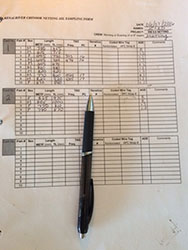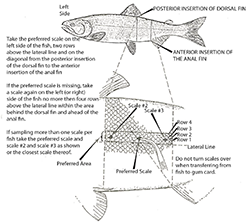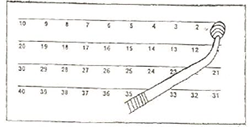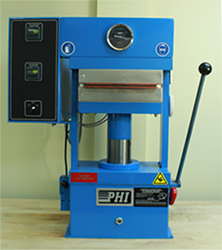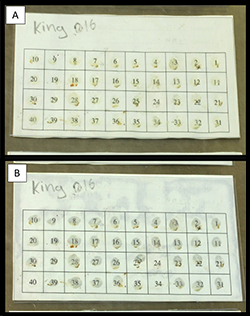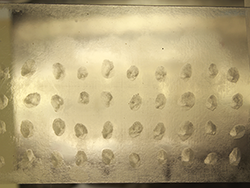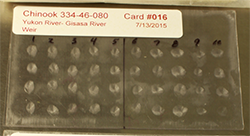Scale Processing
Last modified on Mar 22, 2019
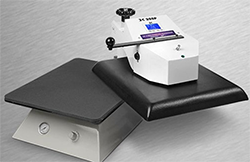
Age-Sex-Length (ASL) collection
Salmon biological data, such as age, sex, weight, and length, are collectively referred to as ASL (or AWL) data. Often, ASL data are recorded on paper forms or electronically via handheld computers. Sampling and processing of fish occurs at a variety of locations, including at fish processing facilities and weirs, during creel surveys, on vessels, or during other field surveys. Specimen numbers from a particular sampling event are used to match ASL measurements and samples taken on a particular fish with other measurements and samples collected from the same fish. These include coded-wire-tag, genetics, otolith thermal mark, pathology, and chemical analyses.
Electronic ASL data collection requires infrastructure and field testing but is a reliable way to ensure data is collected in a consistent format. At present, ASL data is recorded electronically in many locations throughout Alaska, but hand written forms are still used where field computers are not practical.
At a minimum, the following fields should be recorded during ASL data collection:
- Date
- Location name
- Species
- Scale card number (or sample number)
- Harvest method (e.g., hook and line, gillnet, seine, trawl, etc.)
- Name of person recording the data
For each fish:
- Fish specimen number
- Length
- Sex
Sample location on fish
Scales of individual fish vary in size and shape (Mosher 1963). Salmon scales are formed within their first year of life, and annuli can be seen on all scales. However, centrally-located and first-formed scales have the most regular shape and are the easiest to interpret for age (Clutter and Whitesel 1956). Scales that are 6 or more scales above the lateral line are formed later than scales formed closer to the lateral line, which makes the freshwater portion of the scale smaller. Relatively smaller freshwater zones sizes makes distinguishing freshwater age difficult (Scarnecchia 1979). When sampling, scales >6 rows above the lateral line should be avoided.
The preferred sampling location on the body of a fish is within three scale rows above the lateral line and between the posterior insertion of the dorsal fin and anterior insertion of the anal fin on the left side of the fish (Figure 1; Mosher 1963; Scarnecchia 1979). If scales are not present in the preferred area, alternative scales should be taken in the following order:
- Along the lateral line towards the dorsal or caudal fin (Figure 2).
- Right side of the fish in the same area (three scale rows above the lateral line and between the posterior insertion of the dorsal fin and anterior insertion of the anal fin). Scales taken from the right side of the fish will show the same growth patterns.
After a scale is removed from the fish, remove tissue and debris from the scale by cleaning it between two fingers, or by wiping the scale against a textured surface, such as a sleeve or neoprene cuff. Tissue and debris left on the scale obscures the circuli patterns and can inhibit age estimation.
Gummed card
Gummed cards are 4" x 2.5" paper cards; one side is "gummed" with a coating of water soluble glue, the other is not. Scales are placed on the gummed side of the card on a numbered position (typically, position numbers are 1 through 40). The other side of the card is not gummed, and typically has space for sampling information.
Scale placement on gummed card
After removing the scale from the fish (scales should be placed on a gummed card so that the smooth side of the scale is pressed against the gummed card and the ridges (circuli) are away from the card (Figure 3). This is important because the ridges are pressed into an acetate to form an impression. If a scale is placed with its ridges down, the scale will not be readable (see scale imperfections section).
Scales must be moist to ensure good adhesion to the gummed card. Position moist scale directly over a number, and place each scale in a consistent orientation. Place the scale so that the rounded margin is up and at the same angle. Scales with inconsistent orientation increase amount of time needed to estimate age. Apply slight pressure with finger to ensure good bond with gummed card.
Typically, 3–4 scales are sampled per fish for Chinook salmon. Scales from the same fish are placed in a single column (see sample size and rate page). For typical gummed cards, this means there are 30-40 scales from 10 fish on each full gummed card.
Gummed card labels
Label each gummed card with sampling information:
- Card number: card numbers should be uniquely numbered by year, location, and project type
- Sample date (month, day, and year)
- Location or sub-district
- Project type (e.g. commercial, escapement)
- Species
Use a pencil to write on the gummed card, because ink will dissolve and smear when in contact with water. In the field, gummed cards can be stored between waxed paper, which helps keep them from sticking together. At the end of each day, dry the cards before long-term storage. After the cards are dry, the waxed paper can be removed from the bundle, and an acetate or cardboard cards cut to the same size as the gummed cards can be placed around the bundle to help keep the gummed cards flat.
Scale pressing
Gummed cards are pressed against an acetate to leave an impression of the scales (Clutter and Whitesel 1956). Acetates are typically 4" x 2.5" x 0.015" or 0.020" pieces of clear-lay plastic.
There are two types of presses used in Alaska: hydraulic (Figure 4) and air-operated (Figure 5). Air-operated presses require an air compressor. The pressure, temperature, and duration of press to use for the best quality press changes with the thickness and composition of the acetate. Other materials used while pressing scales are commercial grade silicon heat guards and a baking sheet.
Processing time varies, but generally lasts a few minutes. Pressing multiple gummed cards at a time saves time. While processing multiple cards, it is helpful to write the card number on the gummed side of the acetate, using pencil, to keep track of the gummed card and acetate pairs (Figure 6).
The quality of the scale impressions (presence and thickness of impressions) can be reviewed soon after the acetate cools (Figure 7). Impression will be too light to read if the correct combination of pressure, temperature, and time are not used.
Acetate labels
Each acetate card should be labeled with:
- Year
- Species
- Project type (e.g. commercial, escapement, etc. See data recording and entry)
- District, sub-district, or stream code
- Gear type
- Card number
Include additional information needed to uniquely identify the card (Figure 8). More data may be required, such as sampling crew or specific location. It is helpful to have a consistent number of characters for the card number. For example, numbering a card with "001" clearly identifies this card number from other card numbers, e.g. "010" in case other numbers are written around the card number.
On the acetate, scale position corresponding to the first fish should be labeled with a "one" written on the acetate and a line should be drawn between the scales from the fifth and sixth fish. These written markers help quickly identify the position on the acetate and prevent data entry errors. Use a fine-tip permanent marker to label the acetate.
References
Burkey, C., Jr., M. Coffing, J. Menard, D. B. Molyneaux, P. Salomone, C. Utermohle, and T. Vania. 2000. Annual management report for the subsistence and commercial fisheries of the Kuskokwim area, 1999. Alaska Department of Fish and Game, Division of Commercial Fisheries, Regional Information Report 3A00-29, Anchorage. http://www.adfg.alaska.gov/FedAidPDFs/RIR.3A.2000.29.pdf
Clutter, R., and L. Whitesel. 1956. Collection and interpretation of sockeye salmon scales, volume 9. International Pacific Salmon Fisheries Commission Bulletin, New Westminster, Canada.
Koo, T. S. 1955. Biology of the red salmon, Oncorhynchus nerka (Walbaum) of Bristol Bay, Alaska as revealed by a study of their scales. University of Washington.
Mosher, K. H. 1963. Racial analysis of red salmon by means of scales. International North Pacific Fisheries Commission Bulletin 11: 31-56.
Scarnecchia, D. L. 1979. Variation of scale characteristics of coho salmon with sampling location on the body. Progressive Fish-Culturist 41(3):132-135.
Product names used in this publication are included for completeness and do not constitute product recommendation or endorsement.

